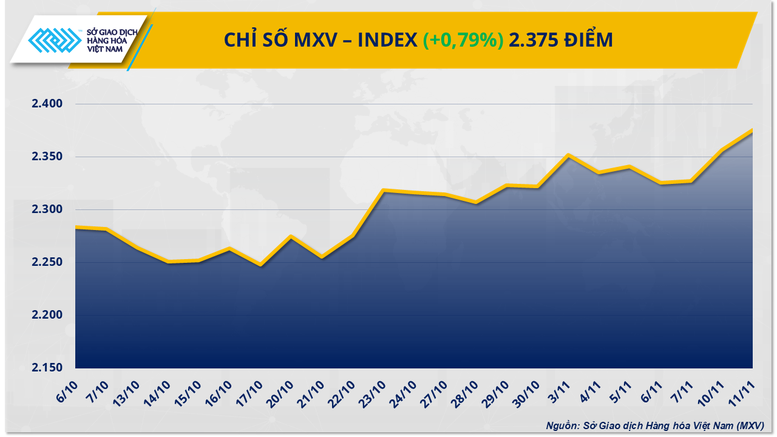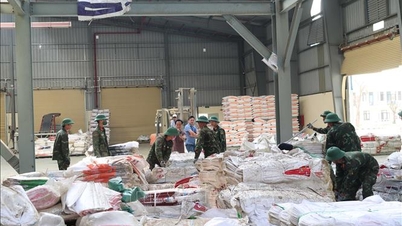
Supply pressure continues to weigh on the cocoa market
At the end of yesterday's trading session, the industrial raw material market recorded clear differentiation between commodities. Notably, cocoa prices, after reaching a 6-week high on Tuesday last week, returned to a downward trend when the world's main production and supply region - Africa - received good news about the crop. At the end of yesterday's session, cocoa prices continued to decrease by nearly 4.5% to 5,829 USD/ton.
Chocolate maker Mondelez recently reported that cocoa production in West Africa is now 7% above the five-year average, and is “significantly ahead” of the same period last year. Harvesting is also progressing well as West Africa is currently in a dry period, but still sees light rainfall, which helps maintain moderate soil moisture. The dry weather not only helps with harvesting and drying, but also makes transportation easier as roads are less muddy.

In Ivory Coast, cocoa arrivals remained high last week, contributing to improved supply to the international market.
Meanwhile, global demand for cocoa continues to weaken, becoming a factor putting pressure on the market in the medium and long term.
In Asia, the Regional Cocoa Association reported a 17% year-on-year decline in cocoa grinding production in the third quarter to 183,413 tonnes – the lowest for the third quarter in nine years. A similar trend was seen in Europe, where grinding volume fell 4.8% to 337,353 tonnes, a 10-year low for the same period.
In contrast, in North America, the National Confectioners Association said third-quarter grinding output increased 3.2% year-on-year to 112,784 tons. However, analysts note that this figure may not accurately reflect reality, as many new companies are reporting. Data from research firm Circana shows that in the 13 weeks ending September 7, chocolate candy sales in North America fell more than 21% compared to last year, indicating that consumer demand remains low.

Corn prices edge up on hopes of improved consumption
According to MXV, the agricultural market recorded mixed developments among commodities, in which corn prices stood out with an increase of more than 0.5%, to 170 USD/ton, extending the increase into the second session. The main driving force for price increases came from expectations of improved global consumption demand.
Notably, the Thai government has approved a plan to sharply increase corn imports from the US and reduce import tariffs to 0%. According to spokesman Siripong Angkasakulkiat, Bangkok will import 1 million tons of corn duty-free between February and June 2026, nearly 20 times higher than the previous annual quota of 54,700 tons with a 20% tariff.
Mr. Siripong said the move was part of trade negotiations with the United States, adding that the government would require importers to buy three times the amount of domestic corn to avoid putting pressure on domestic prices.
At the same time, Taiwan’s MFIG Group has offered to buy 65,000 tonnes of corn for animal feed, with supplies likely to come from the US, Argentina, Brazil or South Africa. This move contributes to strengthening confidence in the recovery of import demand in the short term.
On the other hand, global corn supply remains at risk. In China – the world’s second-largest producer, prolonged rains and floods in October have affected more than 364,000 hectares of crops, especially in the two key provinces of Henan and Shandong.
In the US, analysts expect the US Department of Agriculture (USDA) to lower its corn yield estimate in its upcoming November report, reflecting poor weather conditions late in the season. However, the news that 95% of the corn acreage has been harvested suggests that actual supplies remain relatively abundant.
Meanwhile, US corn exports in the week ending November 6 only reached about 300,000 tons, a sharp decrease due to the decline in demand from Mexico, creating certain pressure on the price recovery momentum.
Overall, corn prices edged up in the latest session on improved consumption expectations and supply risks in Asia, but gains were capped by slowing US exports and the near completion of the harvest.
Source: https://baochinhphu.vn/thi-truong-hang-hoa-ca-cao-rot-gia-ngo-phuc-hoi-nhe-102251112100045941.htm



![[Photo] Highways passing through Dong Nai](https://vphoto.vietnam.vn/thumb/1200x675/vietnam/resource/IMAGE/2025/11/12/1762940149627_ndo_br_1-resize-5756-jpg.webp)



























































































![Dong Nai OCOP transition: [Article 3] Linking tourism with OCOP product consumption](https://vphoto.vietnam.vn/thumb/402x226/vietnam/resource/IMAGE/2025/11/10/1762739199309_1324-2740-7_n-162543_981.jpeg)








Comment (0)